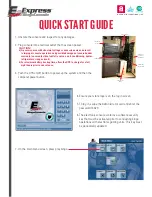
57
Bicycle chain maintenance:
Bike chains are parts which are typically sub-
ject to wear. They should be replaced at the fol-
lowing intervals.
• Hub gears: from approx. 3,000 km
• Chain gears: approx. 1,500-2,000 km
Turn the crankset into the position where the
tension of the chain is greatest or where the
chain sag is least.
In this position, you should be able to move the
free chain by around 2 to 3 cm without the need
for much force.
If the tension of the chain is too high or too
low, the fixture of the bottom bracket eccentric
loosens.
In your FLYER Tandem, the eccentric is
clamped internally. The fixture is administered
by an allen key screw from the side.
• Having the correct chain tension is very im-
portant for hub gear systems. There has to
be one to two centimetres of vertical play
between chain ring and sprockets.
Excessive play can lead to the chain falling off.
Too little play in contrast can lead to the chain
wearing prematurely.
Here is the basic approach to retightening
the bike chain:
• Loosen the axle nuts
• Pull the rear wheel backwards until the
chain has achieved the level of tension de-
scribed.
• Carefully tighten all loosened screwed con-
nections in a clockwise direction.
22.2 Tensioning a tandem chain!
Ensure you adhere to all pre-
scribed torques. Otherwise,
parts could become loose or
break the screws (see chapter 33.3
“Torques for screwed connections”).
A worn bike chain can break and
cause very serious falls. For
this reason worn bicycle chains
should be immediately replaced by your
specialist retailer and not used on pub-
lic roads before this work has been car-
ried out.
min
>3 cm
Содержание Flyer
Страница 1: ...Operating manual ...
Страница 2: ......
Страница 3: ......
Страница 4: ...Info Lo Power Hi Mode ...
Страница 92: ......
Страница 93: ......
Страница 94: ...Supplied by ...
















































